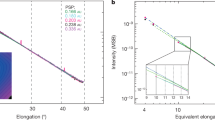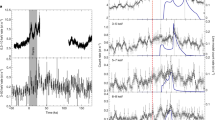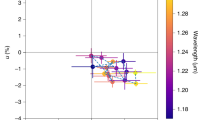Abstract
IN an article on the corona, published in the November number of the Astrophysical Journal, I suggested a method by which the existence of the Fraünhofer lines in the spectrum of the corona might be detected. The method was based on the supposition that the light emitted by the particles, in virtue of their incandescence, so overpowers the reflected sun-light that the lines are invisible. That the coronal light is strongly polarised is well known, and there is scarcely any doubt but that the polarised light is reflected sun-light. If, now, a Nicol prism be placed before the slit of the spectroscope in such a position as to transmit the polarised radiations, these will be allowed to pass with almost undiminished intensity, while the emitted or unpolarised light will be reduced in intensity by one-half. The great change in the ratio resulting might easily be sufficient to bring out the dark lines distinctly. I feel firmly convinced that this experiment should be tried at the Sumatra eclipse of next May, for I have successfully accomplished it in the laboratory with an artificial corona. It was found that a gas flame in a strong beam of sun-light shone with a pure bluish-white light, due to the reflection or rather scattering of the sun-light by the minute carbon particles.1 The flame thus illuminated showed the Fraünhofer lines distinctly, but by reducing the intensity of the sun-light a point was reached at which they disappeared, and the spectrum appeared continuous. The light scattered by the flame was found to be completely plane polarised in certain directions, giving us just the required conditions, namely, particles emitting a continuous spectrum, and scattering a polarised solar spectrum. In front of the slit of the spectroscope a Nicol prism was arranged in such a manner that it could be drawn into and out of position by a cord. The Fraünhofer lines could be made to appear by sliding the Nicol in front of the slit, and disappear by drawing it away. While it does not by any means follow that the use of a Nicol on the actual corona will bring out the lines, the experiment seems to be well worth trying, as it would furnish further information regarding the relative intensity of the emitted and reflected light.
This is a preview of subscription content, access via your institution
Access options
Subscribe to this journal
Receive 51 print issues and online access
$199.00 per year
only $3.90 per issue
Buy this article
- Purchase on Springer Link
- Instant access to full article PDF
Prices may be subject to local taxes which are calculated during checkout
Similar content being viewed by others
Author information
Authors and Affiliations
Rights and permissions
About this article
Cite this article
WOOD, R. On the Nature of the Solar Corona, with some Suggestions for Work at the next Total Eclipse. Nature 63, 230–231 (1901). https://doi.org/10.1038/063230b0
Issue Date:
DOI: https://doi.org/10.1038/063230b0
Comments
By submitting a comment you agree to abide by our Terms and Community Guidelines. If you find something abusive or that does not comply with our terms or guidelines please flag it as inappropriate.



